17 October 2017
Research is the systematic search for knowledge. Editorializing is presenting one’s opinions and interpretations, sometimes with examples specifically chosen to prove one’s point. When it comes to the Voynich Manuscript, it’s probably best to emphasize the former, since very little is actually known about the VMS.
Spirals and whorls were discussed recently on the voynich.ninja forum and, on October 15, 2017, D.N. O’Donovan posted a brief blog comprising a montage of seven images with the Latinesque title: Floribus campis Coeli. There is no commentary and I have only read a few of O’Donovan’s blogs, so I don’t know the background on these images, but one of the captions reads,
“As noted in the first of my posts mentioning this whorl motif in Beinecke MS 408, one finds early examples in Ephesus, Antioch and Rhodes but it reached the South-western Mediterranean no later than the 7thC AD.”
I haven’t made a systematic study of spirals or whorls, I’ve mostly concentrated on the Voynich Manuscript text and plants, but I have gathered a few images along the way.
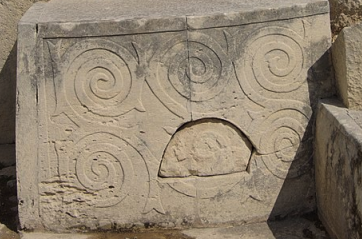
Spiral reliefs in wave and garland patterns decorate the Temple of Tarxien on the island of Malta [image courtesy of Wikipedia].
Megalithic courtyards, as the Maltan Temple of Tarxien, are well-decorated in wave- and plant-like spirals, and the Romans who occupied Malta from the 3rd century BCE, continued the tradition in their mosaics.
Next to a picture of the “Mosaic Ephesus”, which is a spiral with a sawtooth design, O’Donovan adds,
“In illustrating this mosaic, I was showing the antiquity of spiral armed forms – here it represents ‘all the world under the sun’. In other cases it might represent the sun itself. In one image from the Vms, it represents the rhumbs as I’ve explained.”
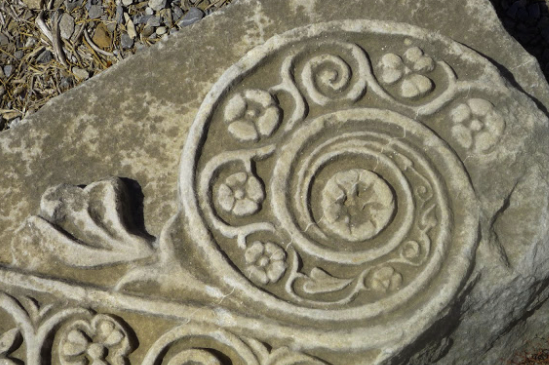
Spiral garland patterns carved into spoglia. [Image courtesy of Rag Rose’s blog.]
Ionic columns in the area also include spiral motifs, as do decorative edges. Since many of the spiral carvings are integrated with floral garlands, it appears that most of the spiral and whorled designs in this complex were inspired by flora and fauna rather than celestial objects.
For reference, here are spiral images from the Voynich Manuscript:
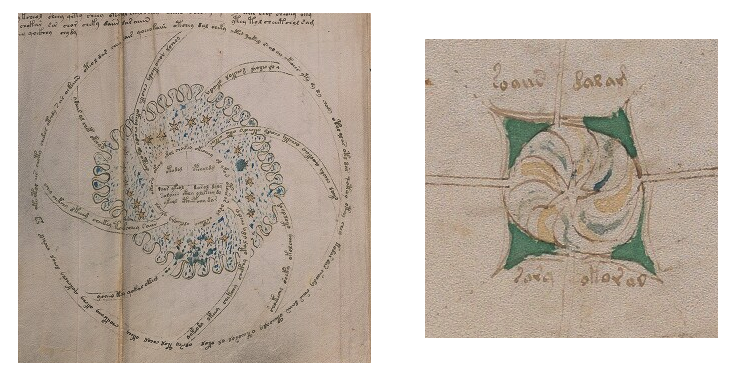
The figure on the left fills most of the page and spirals in a clockwise direction, with text filling the spokes. There is an Armenian astrological diagram that is similar in construction (circles, spokes, and text associated with the spokes) but it does not include the T-O map or the cloudband-like scallops or star-shapes in the central portion. [Edit: 10/26/17 I forgot to mention when I posted this that the Armenian sun-cross was a prevalent symbol, usually consisting of a spiral sun, or a sun-symbol surrounding a cross. You can see examples on Google search.]
The spiral on the right is much smaller, comprising only the center of the page, and radiates in four directions toward other imagery. If you look closely, you’ll see that it originally had nine lines to mark the edges of the spiral arms, which doesn’t bear any relation to the four radiating lines or the six-pointed star, and doesn’t work well if you are trying to paint each section in alternate colors, so the painter fudged the colors on the bottom, with a thin stroke of yellow to separate two blue sections that ended up next to each other.
The Way-Back History on Whorls
Ancient spirals and whorls are found throughout the world, especially in the Americas, Buddhist Asia, Malta, Greece, Turkey, Africa, Ireland, and Scandinavia.
One of the easier ways to make attractive patterns from a piece of wire is to wrap it in a spiral—no exemplars needed—but there are also spirals in the ancient and medieval world that appear to be talismans, or to embody a more specific religious significance. Some patterns are purely decorative, or based on nature (e.g., a curled snake) rather than on religious symbology. One has to study the culture to interpret them correctly.
Studies of ancient imagery are often based on guesswork about the superstitious and spiritual beliefs of cultures for which we have limited information, but some spirals have been found in megalithic sites that are oriented toward the solstices or equinoxes and thus are thought to represent the sun.
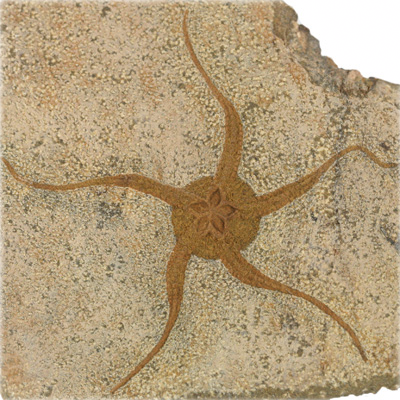
Brittle star fossil found in Mt. El Kissan, southern Morocco {Image courtesy of Fire & Ice].
The picture on the right might look like a petroglyph drawn by a sun-worshipping culture, but it’s actually a brittle-star fossil (Ordovicia) from Morocco.
In the Mediterranean, the patterns of nature were dear to the hearts of ancient people. Even today, the postage stamps of Malta show a rich appreciation of nature’s beauty.
If you look at star shapes and spiral motifs on ancient vases and bowls, you will see many designs inspired by starfish, sun stars (an animal that resembles the starfish), sea urchins, and anemones. Even the little lines and colors in the centers of starfish and sea urchins can be found in Greek decorative arts and Roman mosaics (more on this below).
The Mycenaeans took most of their inspiration from marine life, rather than from the world above them. That’s not to say they were indifferent to the sky… as sea-people, stars were very important to them for navigation, but iconographic analysis has to acknowledge their strong bond to the sea.
Double Entendre
Double meanings are possible in imagery that has multiple interpretations. The stars at the Temple of Karnak in Luxor, for example, are numerous and golden against a blue background, so one immediately thinks of stars, but if you look closely at the way they are drawn, and consider the fact that water is also frequently painted blue, then you have to acknowledge that they may be inspired by starfish, or perhaps be a simultaneous reference to “the stars above and the stars below” [click the pic to see it larger].
Cultural Exchange
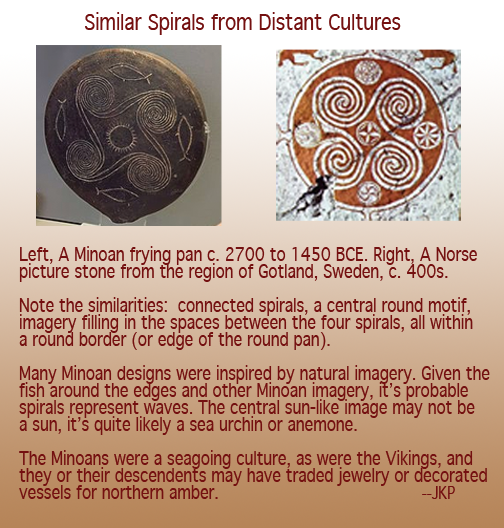 Surprisingly similar quad-spirals have been found on ancient ornaments in both Greece and Sweden (right).
Surprisingly similar quad-spirals have been found on ancient ornaments in both Greece and Sweden (right).
While Scandinavia and the Mediterranean seem far from one another, there was trade between the Norse and early inhabitants of the Iberian peninsula.
The Basques may have served as a communications conduit between the north and the Mediterranean. They were expert mariners and whalers, equal to the Vikings in their seafaring prowess, and crossed paths with the Vikings at stopping points along the coasts of Norway and Iceland often enough that they learned some Icelandic.
The spiral is also a megalithic motif in pre-Celtic Ireland, and the Vikings apparently coerced or kidnapped Hibernian women on their way to Iceland, a fact that is reflected in the DNA of the Icelandic people. Thus, the women of Ireland may have contributed decorative arts to Viking culture.
Spirals are also found in the Canary Islands, whose “discovery” and plunder occurred prior to the creation of the Voynich Manuscript.
Thus, the similarity between northern and southern spirals may not be coincidental.
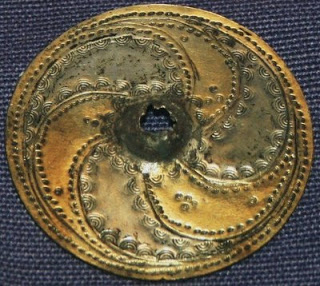 The beautiful spiral on the right bears a strong resemblance to some of the medieval manuscript illustrations containing sun spirals. It is dated to c. 300 CE from Birkenes in southeastern Norway. Some think the design may have originated in Asia, but there are similar spirals (with protrusions on the edges of the main arms) from Sanda, in Gotland, Sweden (c. 400 to 600 CE) and the Gotland picture stones, in turn, resemble Mediterranean designs.
The beautiful spiral on the right bears a strong resemblance to some of the medieval manuscript illustrations containing sun spirals. It is dated to c. 300 CE from Birkenes in southeastern Norway. Some think the design may have originated in Asia, but there are similar spirals (with protrusions on the edges of the main arms) from Sanda, in Gotland, Sweden (c. 400 to 600 CE) and the Gotland picture stones, in turn, resemble Mediterranean designs.
Thus, one sees a chain of communication between the Norse, the Hibernians, and the Mediterraneans, possibly via the Iberian Peninsula, and a pattern of spirals in megalithic and classical art that may be rooted in communication rather than coincidence.
Spirals in Manuscripts
Rayed faces and suns are common to manuscripts from many cultures (they are frequently found in Arabic and Latin manuscripts, as well as the VMS). Spirals are more difficult to find, however, and many of them are more religious than astronomical, but there are some provocative spirals and whorls in the Rothschild Canticles (MS 404, c. 1300) held at the Beinecke Library, that are interesting to examine:
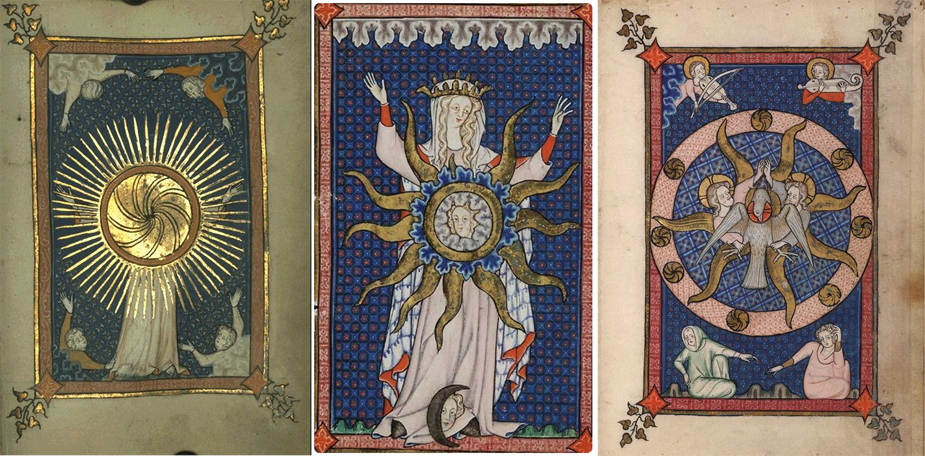
The image on the left, featuring a central spiral with long rays is surrounded by four figures, each with arms outstretched, emerging from cloud bands. The VMS includes a number of images with four figures, some of them with their lower bodies deep in textured patterns. The image on the right also features four figures in the corners, two apparently celestial, the other two terrestrial, and there are round spirals between the rays of the inner whorl.
The central image has a whorl with long starfish-like arms around a central circle with cloudband-shapes radiating in two directions (and rimming the top and bottom edges of the frame). At the base is a face peering out from a crescent moon.
A further image (not pictured) includes four figure in the corners, and three faces in the central wheel with faces ringed by turban rolls not unlike the rolls that frame the faces on the VMS star pages.
There are many other manuscripts with spiral and whorled imagery, these just happened to be at hand, so I include them as visually appealing examples.
Summary
As I mentioned, I have not made a systematic study of these shapes, in fact I’ve barely looked at the parts of the VMS that include them, so I offer the information above as a “quick grab” from my files for those with a specific interest in VMS whorls.
J.K. Petersen
© Copyright 2017 J.K. Petersen, All Rights Reserved

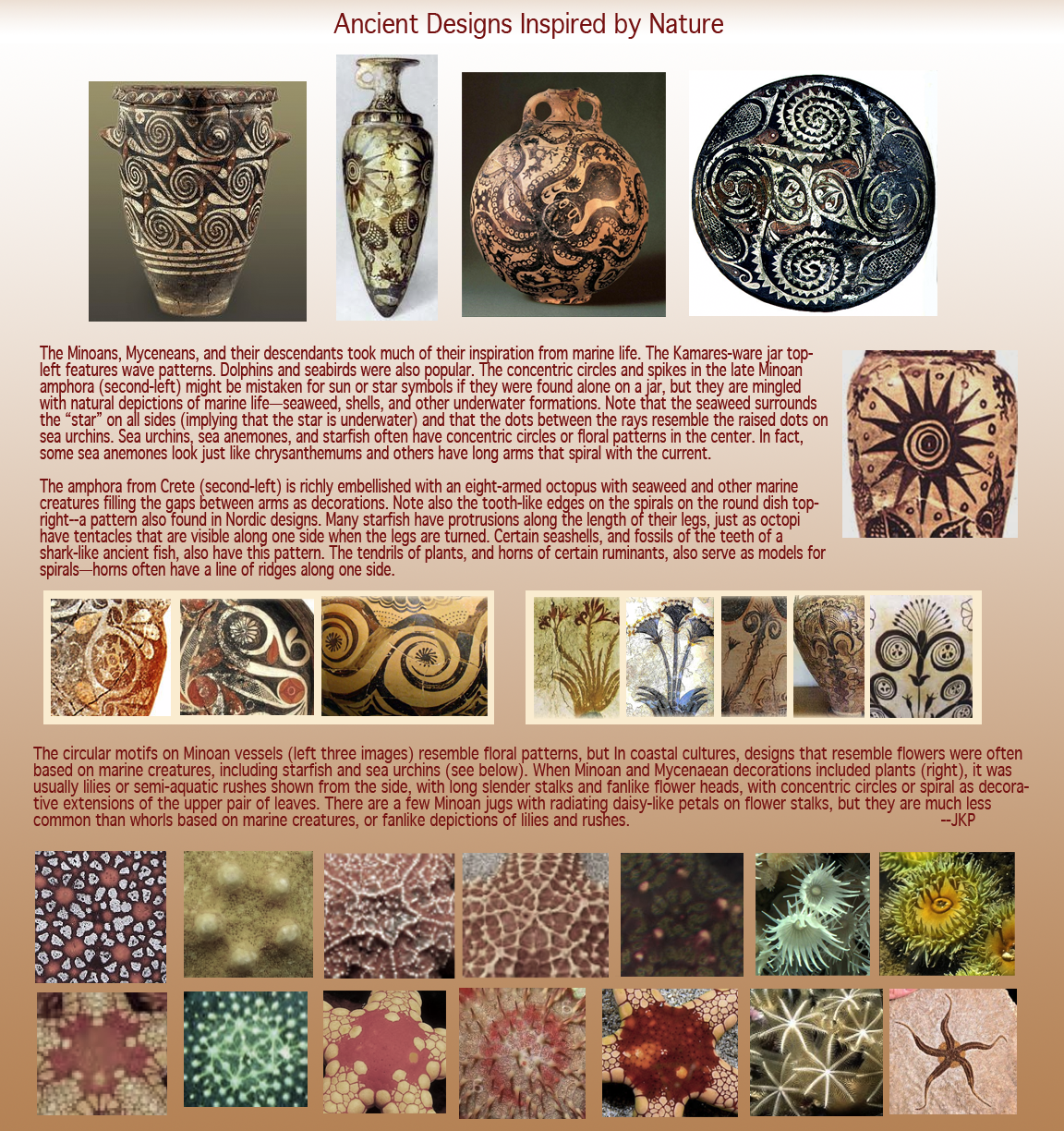
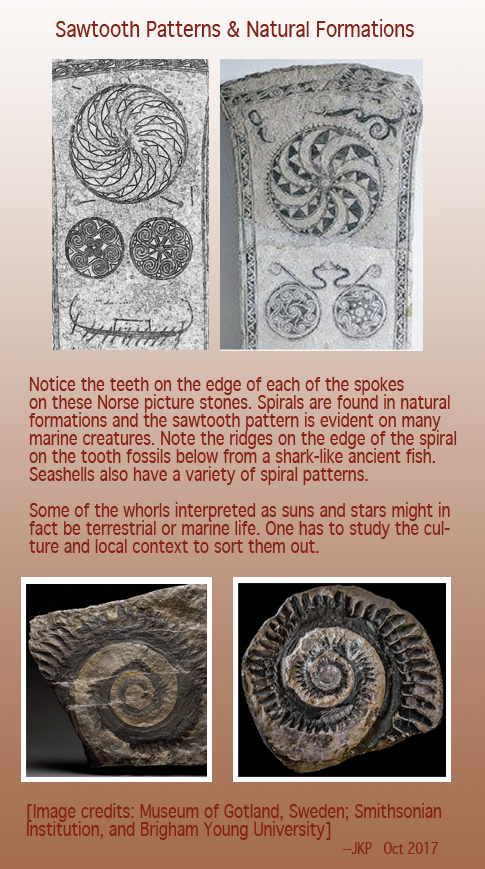
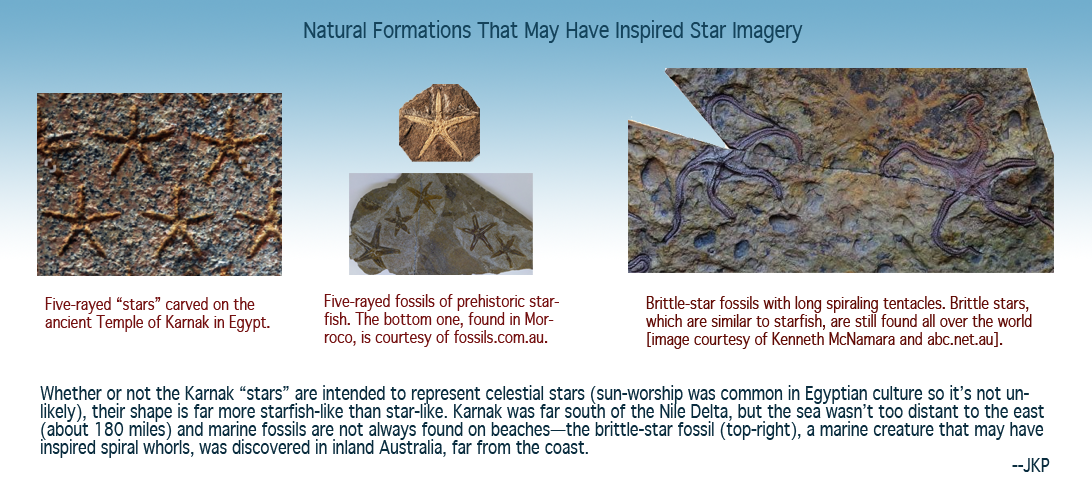
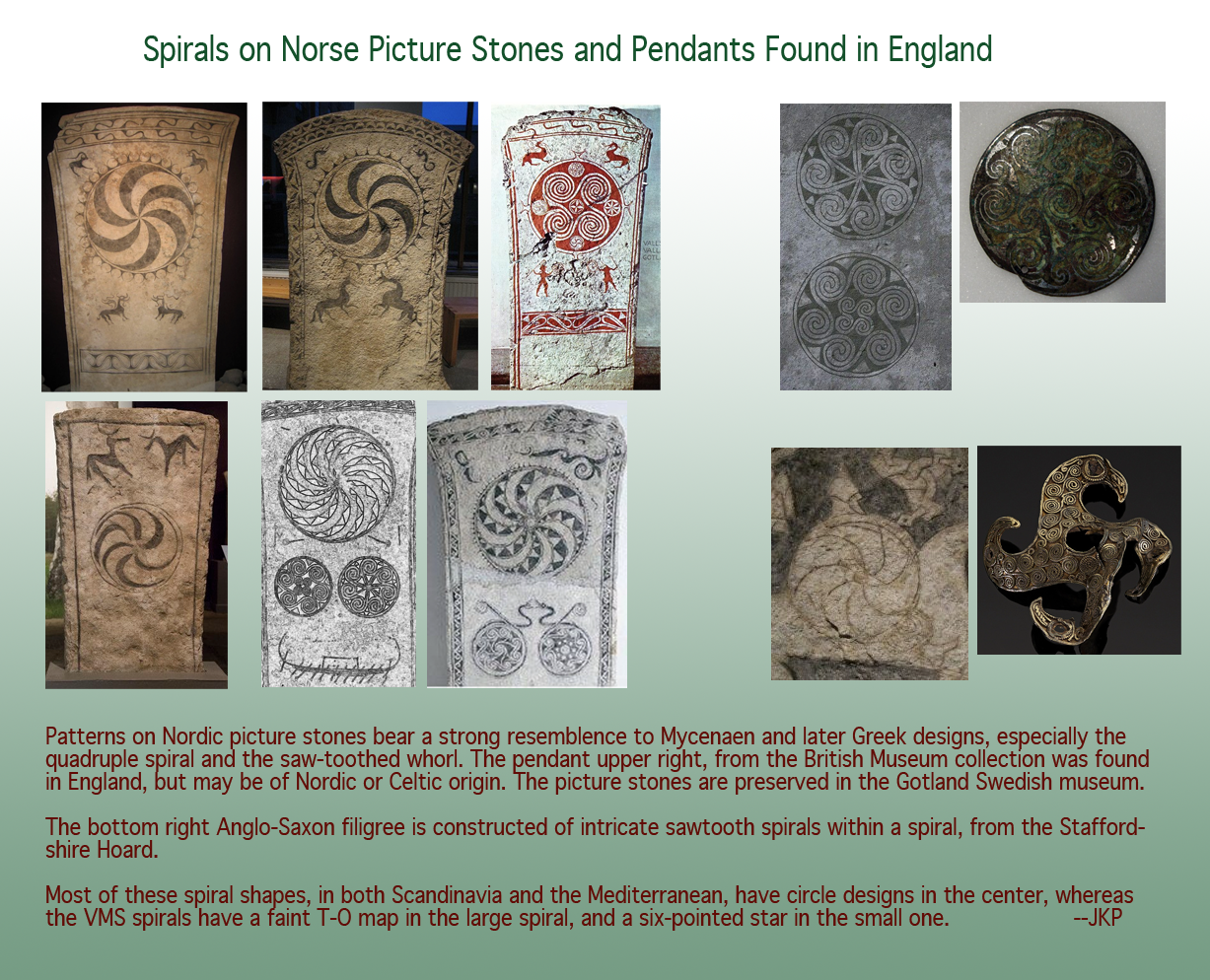
JKP
A nice historical survey of three items, though these are normally treated as distinct. The simple spiral is not found in the Vms, or have I overlooked it?
The critical issue, for Vms studies is not only form, but – most importantly – intended significance.
This factor is one rein (as it were) in directly one’s research; the other is the mapping of where we find, together, the use of a set of similar forms carrying similar significance.
Thus, in that short blog which reprised no more than some key illustrations from my earlier and more in-depth discussions, the point was that we find together in the same region the conception of the star-as-flower TOGETHER with use of the spiral/whorl pattern to signify the sun.
,
This is an unusual combination of themes, so far as I’ve found, and the significance attached to each severally, and both together is the point of the 7thC illustration set first in the ‘assemblage’ recently posted.. or re-posted, depending on how you care to define it.
I liked the image from the Rothschild florilegium. In one of the series written for ‘Voynichimagery’ I commented briefly on the Spain-Flanders entanglements – a fascinating subject and one which I wish I’d had time to go into in more depth.
What is plainly different, of course, is the cultural character evinced. To get it right, any proposed provenance(s) for imagery in the Vms must match form, significance and cultural character INCLUDING recognition of, and discussion of, those marked differences between attitudes and customs in Latin (i.e. western Christian Europe’s) expression of its worldview and what is found in the imagery in Beinecke MS 408.
Since I’ve already published my analyses of the folios in question (which you’ve kindly referenced above for everyone’s convenience – thanks), I won’t waste space repeating any of it here.
Thanks very much for mentioning that little digest of mine. Appreciated.